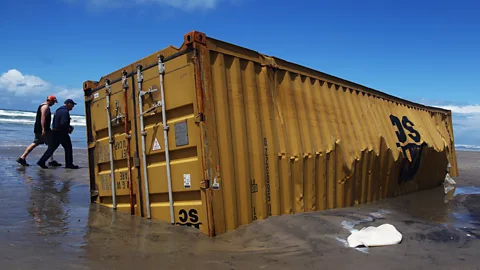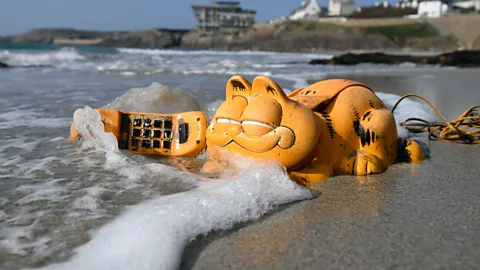The mysterious items washing up on beaches

 Getty Images
Getty ImagesFrom unexplained metal balls to Garfield-themed phones, the strange material that drifts ashore from the oceans can reveal a surprising amount.
It's around 2.5m (8.2ft) wide and about 2.5-3m (8.2-9.8ft) long, cylindrical in shape, but with a dome-like cap – and beachgoers in Australia were left baffled about what it could be.
The mysterious object washed ashore on a beach in Western Australia, about 250km (155 miles) north of Perth. Local authorities are still investigating what the item could be, but police have warned people to keep a safe distance. There was speculation that it could be part of a fuel tank from a space rocket. Reddit users then quickly identifed it as being part of the third stage of India's Polar Satellite Launch Vehicle (PSLV).
It comes just a few months after another strange object – a 1.5m-wide (5ft), almost perfectly sphere washed up on the coast of Japan near the city of Hamamatsu, prompting widespread speculation about what it might be. Despite its metallic exterior, it was probably not an explosive mine – though bomb experts did check. Nor was it thought to be a surveillance device, fears of which have been fuelled by the recent reports of Chinese spy balloons drifting over the continental US.
Neither incident is the first time a mysterious object has appeared on a coastline. In 2019, police in London responded to reports of an unexploded device on the banks of the Thames in Wapping – it turned out to be a giant Christmas bauble.
Every year, the ocean washes up many unusual items that often can't be explained at first.
In recent years, beachcombers have stumbled on:
- An unusual 24m-long (84ft) wood and metal object in Florida in 2022 that people speculated could be a barrier, old pier or even row of spectator seats from a Nascar race. Archaeologists later found it was a shipwreck.
- For 35 years, residents of a coast in Brittany were puzzled why landline telephones based on the cartoon cat Garfield were washing up. The culprit – a lost shipping container – was only recently located.
- A decade ago, blocks of rubbery material engraved with the word Tjipeter appeared all over Europe. They may have come from a rubber plantation in Indonesia. Another rubbery mystery washed ashore last year when a curious layered block found at Falmouth, UK, which may have been a 100-year-old bale of rubber sheets. Another had been found in Shetland, Scotland in 2020.
- A large foam object in South Carolina in 2018 that some outlets labelled as "space junk", but a more sober analysis from local authorities later suggested was a buoy.
One thing that these beach-finds often reveal is just how far objects can travel, and how long they can stay at sea. Materials like plastic or rubber can endure in the ocean for decades, and travel thousands of miles.
 Getty Images
Getty ImagesIn 2020, the National Trust released a list of far-flung items that were found on beaches on the island of Britain: including a fly spray from Russia and an aerosol can from Saudi Arabia, as well as a crisp packet from 1976 and the remains of a 1980s picnic.
Researchers can sometimes guess at the origin of washed-up objects using maps of ocean currents they have been meticulously building. Since the 1980s, marine scientists have used a standardised array of drifting buoys, which send a message about their location every few hours.
A decade ago, oceanographers used this data to build this interactive map, which reveals just how far floating debris can travel. Click on a point in the ocean, and the map will tell you where an item will end up after days, weeks and months. For example, an item dropped off the coast of Japan could reach the coast of California after about three years.
Sometimes, however, debris itself is helping scientists to map ocean currents.
The most famous example of flotsam used for this purpose were the 29,000 plastic turtles, ducks, frogs, and beavers, known as the Friendly Floatees, which fell into the Pacific from the Ever Laurel ship in 1992. They continued to be found more than a decade later, allowing researchers to track the pace, location and reach of ocean currents. (Read more about the secrets being revealed by ocean garbage.)
In Japan, where the giant sphere was found this week, researchers have also turned to flotsam to map currents. These include natural items such as pumice rafts from subsea volcanoes, but also discarded items, such as printer ink cartridges, syringes, golf balls, business cards and drinks bottles, according to Shigeru Fujieda of Kagoshima University.
In a paper published earlier this month, Fujieda proposed a new way to track ocean currents: cigarette lighters. "Disposable lighters are one of the few types of marine litter that have evidence of their source, because they have printed information about the consuming country or city," he writes. What's more, a lighter "can drift a long time on the sea owing to its robust and hollow construction. It can easily be found, picked up, and carried on the beach, because of its bright colour and small size."
 Getty Images
Getty ImagesIn his study, he analysed 79,948 lighters from beaches and estuaries collected across the North Pacific, from Japan to the US, across seven years. This allowed him to map and track the marine litter flows across Asia and the US – which could in principle allow countries to better understand where the polluting plastics and trash appearing on beaches originates from.
In principle, such information could also help to identify how potentially invasive species might cross the oceans on floating debris to colonise new parts of the world. In 2011, the tsunami that hit Japan washed five million tonnes of debris out to sea. Some of it spent more than a year floating in the North Pacific – including the remains of a 18m-long (60ft) dock that drifted for 451 days – before washing up on the shores of the western US and Canada. Hitchhiking with the debris were marine life normally only found in the shallow waters of Japan. Researchers found 289 sea creatures that normally inhabit the coast of Japan among the debris they analysed, including a highly predatory starfish called the Northern Pacific seastar, raising fears they might gain a foothold in North American waters, and begin devastating local biodiversity.
As for that mystery sphere that turned up in Japan, it remained unidentified at the time of writing. Probably the most likely explanation, however, is a little more boring than the wilder ideas on social media: it's likely some sort of mooring buoy. That probably won't stop people and the media continuing to speculate, however, just like they have every time the sea has thrown up a large mysterious object.
* This article was originally published on 22 February 2023. It was updated on 17 July 2023 to include details of the cylinder that washed ashore in West Australia.
--
If you liked this story, sign up for the weekly bbc.com features newsletter, called "The Essential List" – a handpicked selection of stories from BBC Future, Culture, Worklife, Travel and Reel delivered to your inbox every Friday.
